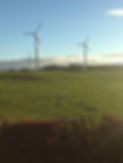

Environment
At Littleton we believe, we can be both a large scale milk producer with a positive environmental impact.
We choose to manage our land to support greater biodiversity and improve natural habitats by planting and maintaining trees, shrubs, grassy field margins, wild bird mixtures and game strips.
Establishing grassy field margins along the river courses reinforces the banks, helping to prevent erosion and slurries or fertilisers from running in to the river, causing nutrient enrichment.
We have reduced the use of artificial fertiliser by 20% and we have reduced our electric costs by 90% with on farm renewable projects
.
Renewable Energy at Littleton
At Littleton we have embraced renewable technology in order to reduce our electric and heat demands from running a dairy farm.
Littleton is probably the only dairy farm in the UK to have every type of renewable technology on one farm.
All over the farm we have installed solar panels on various sheds. There are two wind turbines and a hydro scheme also in place.
There is a Combined Heat and Power system along with a biomass boiler used for hot water and drying of wet materials.
An Anaerobic Digester was installed in 2015 for producing electric and heat for the farm.
We plan to install a ground source heat pump this summer (2021) to provide heat and dry bedding for the cows to lie on.
By harnessing all this renewable technology Littleton has reduced its carbon footprint and is well on the way of becoming net zero by 2045.

Wetland Creation at Littleton
The wetland and pond at Littleton is ideal for attracting wildlife with desirable and suitable vegetation (e.g. reeds) colonising such habitats. South facing banks will therefore receive plenty of light – ideal for a future species-rich grassland area for birds and wildlife.
Overwinter Stubbles and Hedgerow Management
Research has suggested that if around 10% of farmland is kept as overwinter stubbles, then this could provide enough seed-rich habitat to sustain the local seed-eating bird population over the winter months. The fact that you operate a minimum tillage system will likely increase these benefits over the winter months. The best hedgerows for wildlife typically involve A-shaped structures with thick bases. This provides a dense base which attracts nesting birds. This has been carried out at Littleton.
Wild Bird Cover and Nesting Boxes
We looked at a piece of ground between the woodland and burn that could be an ideal place to sow a plot of wild bird cover. As discussed, it can be sown in places to straighten awkward field corners. Wild bird cover plots provide great habitat for invertebrates during the spring and summer, and a seed-rich habitat over the winter months. There is over 50 nests in the sheds at Littleton in the rafters. The birds have free access to food in the form of barley and wheat being fed to the cows.
Woodland Management
Native trees and shrubs have been planted at Littleton farm, in fact
4000 trees have been planted. There is one woodland that has species present in an ancient woodlands.

Wildlife at Littleton
-
A RSPB survey was carried out in 2009. Littleton is a monitor farm and proud member of the RSPB.
-
Habitats are being created to encourage these target birds.
-
Trees and shrubs have been planted under the Farm Woodland Grant Scheme.
Energy use at Littleton
-
An energy audit has been completed by The Energy Savings Trust.
-
Timers and thermostats used to minimise use of electricity.
-
Organic cow manure reduces the usage of synthetic fertilisers.
-
Energy efficient light bulbs on photocell switches.
-
On the new milking parlour there is vacuum on demand milk pumps, heat exchangers and ice builders.
-
This technology will be used to reduce our carbon footprint.
Littleton Farm 28/04/2017

Cropping at Littleton
-
Soil tests every year are used for a nutrient management plan to avoid excess nutrient build-up.
-
Nutrient application based on pH, K and N only.
-
Fields are all located in close proximity to the clamps thus reducing travel times and ultimately diesel usage.
Water use at Littleton
-
Clean water is collected from the roofs and is used for milk cooling and then used to wash down yards, so water is used twice.
-
Water usage is 20 gallons/cow/day considerable less than the standard 30 gallons/cow/day.




